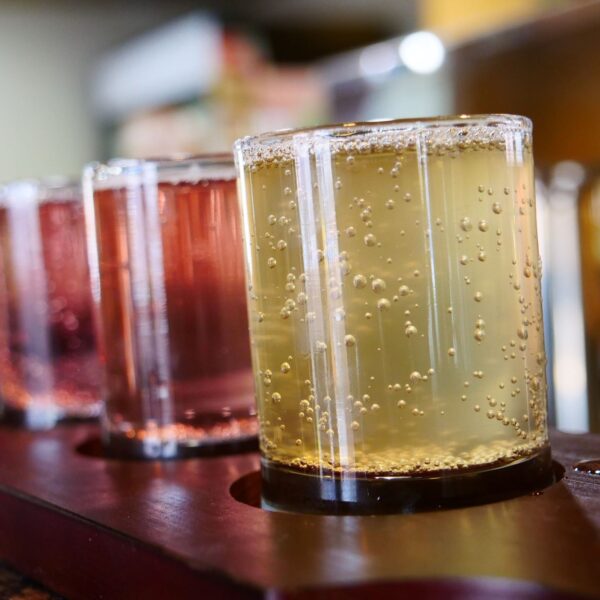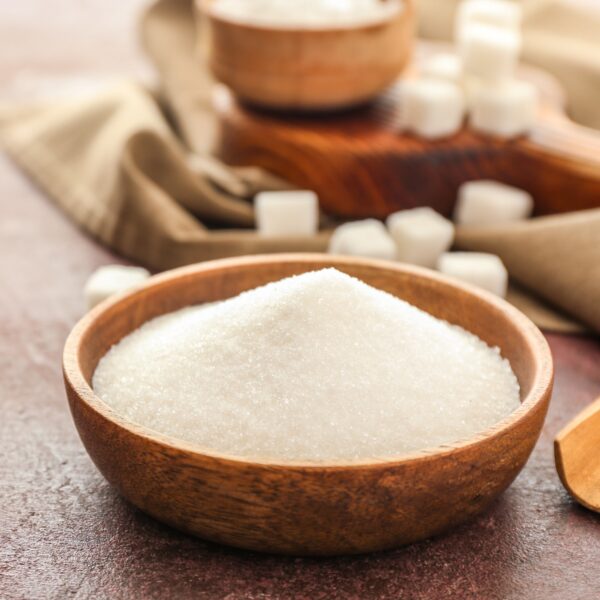Dihydroquercetin, also known as taxifolin, is a unique bioactive flavonoid that has attracted the attention of dietitians and medicinal chemists due to its wide range of health benefits. It is a powerful antioxidant that has been documented as having the ability to prevent malignancies. It’s commonly used in dietary supplements, nutraceuticals, and as a food additive in functional foods.
What is Dihydroquercetin?
Dihydroquercetin (molecular formula C15H12O7) is an isoflavone, a subclass of flavanonols in the flavonoid family. Its basic structure consists of two phenyl groups (rings A and B) joined by a heterocyclic ring called ring C. It has a (2R, 3R)-configuration, and it is a conjugate acid of a (+)-taxifolin (1-), an enantiomer of a (-)-taxifolin. Dihydroquercetin has two stereocenters on the C-ring, and it has four stereoisomers.
Source: Wikipedia
How is Dihydroquercetin Produced?
Dihydroquercetin occurs in plants of various families, including larch, onions, French maritime bark, tamarind seeds, and milk thistle, but is isolated in large amounts (up to 4.5%) only from Siberian larch (Larix sibirica) or Dahurian larch (L. gmelinii). They are the principal raw-material base for the industrial production of taxifolin by aqueous EtOH extraction and further chromatographic purification. Dihydroquercetin is also commercially available in semisynthetic forms.
The Difference Between Quercetin & Dihydroquercetin
Quercetin and dihydroquercetin come from different plant sources. Quercetin is found in citrus fruits, cherries, apples, kale, broccoli, seeds, grains, and red onions. In contrast, dihydroquercetin is commonly found in onions, milk thistle, grapes, green tea, olive oil, and the tree bark of some conifers. According to pre-clinical studies, Dihydroquercetin has two additional atoms of hydrogen per molecule, making it a more powerful antioxidant.
Properties of Dihydroquercetin
| Physical Form | Powder |
| Color | Brown |
| Odor | Characteristic |
| Storage Temperature | 2-8℃ |
| Log P | 0.95 |
| Molecular Weight | 304.25 g/mol |
| Appearance | Brown powder |
| Density | 1.702g/cm3 |
| Melting Point | 237°C |
| λmax | 290, 327 nm |
| Refractive Index | 1.762 |
| Solubility | Soluble in ethanol (61 mg/ml at 25°C), DMSO (61 mg/ml at 25°C), and water (<1 mg/ml at 25°C) |
Typical Formulations
Bread
Here is an example of a bread formulation table with dihydroquercetin, along with the weight of ingredients:
| Ingredient | Composition |
| Wheat Flour | 1000 g |
| Yeast | 20 g |
| Salt | 10 g |
| Water | 530 ml |
| Dihydroquercetin | 0.05, 0.07, 0.1% (Wheat flour basis) |
In a study using this formulation, dihydroquercetin did not cause statistically significant changes in the yeast concentration. Loss of dihydroquercetin during fermentation was established at a level of 20–25%. At the same time, an increase in the total amount of flavonoids in the dough after 2 hours of fermentation and an increase in values of antioxidant activity were noted. The antioxidant properties of the bread also increased when it was enriched with dihydroquercetin (about 3.5–4 times).
Source: MDPI
Soft Capsule
An oral liquid oil composition in which 1-10 parts by mass of astaxanthin is dissolved per 1 part by mass of dihydroquercetin in oil. A soft capsule formulation containing dihydroquercetin and an astaxanthin-containing liquid oil composition was prepared with a similar concentration.
Source: Google Patents
Soft Drink
Here is an example of a soft drink formulation table with dihydroquercetin, along with the weight of ingredients:
| Ingredient | Composition |
| Water | 100 ml |
| Taxifolin | 2-20 mg |
| Fructose: Sucrose (4:1) | 4.5 g |
| Niacin | 1 mg |
| Calcium pantothenate | 0.33 mg |
| B6 | 0.1 mg |
| Biotin | 8.3 mcg |
| Caffeine | 0.011 mg |
| B12 | 0.06 mcg |
| Potassium | 16.5 mg |
| Magnesium | 0.067 mg |
| Chlorine | 21.3 mg |
| Sulfate | 0.65 mg |
Source: Google Patents
Dihydroquercetin Formulation Considerations
Biological Activity
Dihydroquercetin has shown promising inhibitory activity against inflammation, malignancies, cancer, microbial infection, oxidative stress, cardiovascular disease, and liver disease, as described in the table below.
| Antioxidant Activity | – Dihydroquercetin is superior in its antioxidant activity compared to other flavonoids. Having 5- and 7-OH groups in the A- and C-rings allows it to exhibit a powerful scavenging effect on free radicals. – In a study, taxifolin showed 81.02% inhibition of linoleic acid emulsion peroxidation compared to 88.57%, 73.88%, 94.29%, and 90.12% by commercial antioxidants trolox, α-tocopherol, BHT, and BHA, respectively at a similar concentration. – Dihydroquercetin is an effective •OH scavenger that may protect body cells from •OH-induced damage. – In a study, taxifolin was shown to protect the retinal pigment epithelium (RPE) cells against oxidative stress-induced apoptosis by increasing H2O2-induced cell viability, inhibiting intracellular ROS generation, and improving the expression of Nrf2. |
| Anti-Inflammatory Activity | – In a study, taxifolin inhibited the overproduction of reactive oxygen species (ROS) and nitric oxide (NO) via oxidative enzymes. It also inhibited leukocyte infiltration. – Dihydroquercetin inhibits degranulation, generation of leukotriene C4, production of interleukin-6, and expression of cyclooxygenase-2. |
| Anti-Cancer Activity | – The antitumor mechanism of dihydroquercetin mainly includes the inhibition of angiogenesis, cytochrome P450 enzymes, P-glycoprotein, reactive oxidative species (ROS), and cell cycle regulators, as well as the induction of apoptosis. – Dihydroquercetin causes cell cycle arrest and tumor regression by activating Wnt/ β -catenin signaling pathway in colon cancers. |
| Hepatoprotective Activity | – In a study, taxifolin increased the ATP phosphohydrolase activity in liver homogenates in arthritic animals. – Dihydroquercetin exhibits hepatoprotective activity by inhibiting lipid peroxidation via an increase in the activities of antioxidant enzymes, such as GPx, SOD, and GRd. – Dihydroquercetin prevents concanavalin A-induced hepatic injury in mice and inhibits TNF-α/ActD-induced apoptosis. – Dihydroquercetin decreases hepatic lipid synthesis with a concomitant decrease and increase in apoB and apoA-I secretion. |
| Cardioprotective Activity | – Dihydroquercetin helps to decrease the atherogenic index by maintaining a normal lipid profile in the serum and liver as well as through lipid excretion. – Dihydroquercetin inhibits cholesterol synthesis, reducing HMG-CoA reductase activity and suppressing cellular cholesterol esterification]. |
| Antimicrobial Activity | – Dihydroquercetin is effective as an antibacterial against bacterial pathogens, including S. Mutans & L. Acidophilus, S. epidermis, M. luteus, E. coli & P. aeruginosa. – Dihydroquercetin protects against pneumonia induced by lethal doses of methicillin-resistant Staphylococcus aureus. |
| Neuroprotective Activity | – In a study, taxifolin exhibited neuroprotective actions against the oxidative injuries induced in cortical cell cultures. – In a study, taxifolin inhibited the activity of nuclear factor-kappa, which signaled the up-regulation of inflammatory proteins in cerebral ischemic reperfusion injury. |
Absorption & Metabolism
Dihydroquercetin undergoes rapid absorption from the GI tract and is distributed to the blood plasma, liver, heart, spleen, brain, skeletal muscles, lungs, and kidneys and is then metabolized and excreted via urine. In the colon, dihydroquercetin undergoes metabolism of hydration, dehydration, and ring-fission through the gut microflora. The main metabolites of dihydroquercetin in plasma and urine are its sulfated, glucuronidated, and/or methylated products. Dihydroquercetin and its metabolites may be quickly absorbed and distributed in the tissues.
In a study, the maximum concentration of dihydroquercetin in blood plasma was detected after 30 minutes of oral administration of the drug, which was absorbed quickly from the gastrointestinal tract, and the levels were undetected after eight hours. The excretion of taxifolin and its metabolites in urine was much faster than in feces, and the total excretion was 1.96 ± 0.23% during 12 hours.
Bioavailability
Dihydroquercetin has a high safety profile but low bioavailability limiting its use. Innovative techniques (liposomization, crystal engineering, etc.) can increase its bioavailability.
In a study, the plasma concentration was much less after oral administration of dihydroquercetin at a dose of 10-100 mg/kg body weight. The absolute bioavailability of dihydroquercetin in rats was 0.17%.
The bioavailability of dihydroquercetin from lipid solution for oral administration was higher than that by oral administration of dihydroquercetin tablets. Flavonoids are conjugated with sulfate and glucuronic acid in organisms. In a study, dihydroquercetin was dissolved in Labrasol and used as a dosing solution for oral administration. The total bioavailability of conjugated and free dihydroquercetin in vivo after enzymatic hydrolysis of the sample with glucuronidase and sulfatase was 36%.
Dosage Format
The lower solubility of dihydroquercetin significantly limits its bioavailability and efficacy. Different novel dosage forms and delivery systems are developing to increase the bioavailability, solubility, and permeability of dihydroquercetin. One study used micronization technology to generate microscopic and uniform amorphous taxifolin nanoparticles. In another study, modified taxifolin liposomes manufactured using a thin-film hydration technique helped with the release rate in gastrointestinal environments. Another study used lyophilization to generate new phase modifications of dihydroquercetin, which increased water solubility at least 30-fold, improving the bioavailability.
Safety & Regulatory Considerations
| FDA Information | The FDA has informed about the GRAS status of dihydroquercetin and approved its use as a dietary ingredient with dosage limits. |
| EU Information | The taxifolin-rich extract of Dahurian Larch has been included in the list of novel foods by the EU. |
Safety & Toxicity of Dihydroquercetin
Various studies support the safety of taxifolin consumption as a food supplement and additive. The toxic potential of dihydroquercetin was calculated to be 0.289 using VirtualToxLab, which quantifies toxic potential ranging from 0.0 to 1.0, with values above 0.6 indicating high toxicity.
In a subchronic rat study performed following OECD standards, the highest dose tested (i.e., 1,500 mg/kg bw) was considered to be the NOAEL. The margin of exposure (MOE) of the combined intake (158 mg) from the intended food uses (including 100 mg from food supplements) would result in about 660 for an adult weighing 70 kg. [32]
Identification Numbers
| IUPAC Name | (2R,3R)-2-(3,4-dihydroxyphenyl)-3,5,7-trihydroxy-2,3-dihydrochromen-4-one |
| CAS Number | 480-18-2 |
| EC Number | 207-543-4 |
Maximum Usage
The maximum usage level of dihydroquercetin in food per the FDA is as follows:
| Category | Usage Level |
| Non-Alcoholic Beverages | 0.02 g/L |
| Yogurt | 0.02 g/kg |
| Chocolate Products | 0.07 g/kg |
Fun Facts About Dihydroquercetin
- Dihydroquercetin has been studied for its potential to protect against ultraviolet (UV) radiation. It may help reduce skin damage caused by UV exposure.
- Dihydroquercetin has been shown to possess metal-chelating properties. This means it can bind to and potentially neutralize harmful metal ions in the body.







